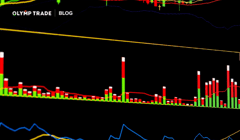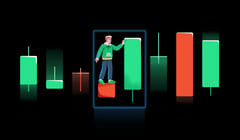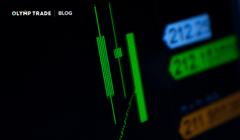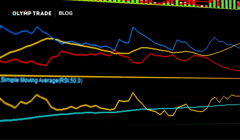
To profit in Forex, traders need to make correct price forecasts. There are two types of activities that help produce such correct forecasts. The first is observing and analyzing the trading instrument’s chart patterns, which is technical analysis. The second is fundamental analysis, which is understanding the economic factors that influence the price. Understanding the nature of each and the difference between them helps find the right balance of the two to best fit each trader’s objectives.
Contents
- The Essence of Technical and Fundamental Analysis
- How to Do Fundamental Analysis
- Examples of Fundamental Analysis Approaches
- How to Do Technical Analysis
- Combine Technical and Fundamental Analysis
Interact with the dashed blue word and green spot on images to get additional details and explanations.
More details on the visuals will be here.
A term definition or explanation will be here.
The Essence of Technical and Fundamental Analysis
Fundamental analysis examines the real-world factors that impact the price of a trading instrument.
The goal of fundamental analysis is largely to understand whether the trading instrument’s value is expected to rise or decline in weeks, months, and years, and what the reasons for that may be. Therefore, it is usually about long-term trading and investing.
Technical analysis focuses on the price charts, patterns, indicators, and trends. It usually provides a good read on the current price behavior and the market sentiment.
The goal of technical analysis is also to understand where the trading instrument’s price will likely go. However, in contrast to fundamental analysis, technical analysis is usually about the short and mid-term price forecasts.
So, both types of analysis have a common goal, which is forecasting the price. However, they differ in their methods and the time frame.
How to Do Fundamental Analysis
Essentially, fundamental analysis is about going in-depth about your chosen trading instrument.
It suggests you understand the nature of your instrument, the factors that affect its price, the larger context of its market sector or industry, and the relevant strategic dynamics in the economy.
| For a currency pair, familiarize yourself with the monetary policy of the central banks whose currencies you trade. | For a stock, understand the nature of its business sphere, and the economic setting in which your trading instrument exists. |
|---|---|
| Ask yourself whether you are trading a primary global reserve currency such as USD or EUR that is expectedly stable in the long run? Is it a volatile currency pair of regional importance such as AUD/NZD? Is it a local currency such as TRY that may lose or gain hundreds of percent of value in weeks? | If you are into stocks, you will want to know if you’re trading on a hi-tech stock such as Nvidia that is likely to be affected by chip shortages or a century-old global producer of beverages such as Coca-Cola. |
This is the type of information that you’ll start your fundamental analysis with.
How can you answer the questions set by fundamental analysis? Read.
Here are some suggestions on what to read:
- Corporate news relevant to the stock you trade on.
- Central bank reports relevant to the currency pair you trade.
- News that is likely to affect the price of your trading instrument.
Here are some real-case examples of fundamental analysis for oil, a currency pair and stock.
Examples of Fundamental Analysis Approaches
Brent Crude Oil
If you trade Brent crude oil, read the latest news of OPEC+ to understand what their estimation of the future oil demand is and what their policy will likely be. Research the global energy and geopolitical issues that may impact it such as the decade-long sanctions on Iran. See who the main global consumers of oil are and their economic condition. For example, if China has upbeat economic growth prospects, it will likely require increasing oil supplies, and that will support the oil price. If the Chinese economy is sufficiently suppressed by certain factors that may slow down its economic expansion, it will probably require less oil, and Brent will experience downward pressure.
USD/MXN
If you trade the Mexican Peso, read the latest statements and listen to press conferences of the Central Bank of Mexico. Understand how it is planning to manage the value of the Peso. Research the general conditions of the Mexican economy in relation to the US economy as that will largely affect the mutual standing of MXN and USD. Check out the latest statements of the Mexican President to understand the general direction in which Mexico will likely be guided. Examine it all against the US economic dynamics and comments by the US Fed Chair that will provide insights on the future of USD. Together, it will provide a vision of where USD/MXN will likely head.
Alibaba
Understand what Alibaba’s market sector is and who its competitors are. It is important because Amazon and eBay are roughly in the same industry, so their performance will indirectly affect the performance of Alibaba. Read its latest financial reports to see its performance first-hand. Identify the possible reasons for Alibaba’s dynamics to have a fair expectation of where it will likely head. Put all that into the context of Alibaba’s country of origin. Since the Chinese authorities started the crackdown on the Chinese IT industry in 2021, Alibaba’s stock has seen an almost uninterrupted decline. That means, once it’s over, the stock may rise again. When will it be over, and will it? That will define Alibaba’s future growth potential, and doing thorough research may help better understand it.
How to Do Technical Analysis
In essence, technical analysis is when you look at the price chart and make the price forecast based on what you see. There are several ideas that make up the core of this activity.
Find Trends on the Price Chart
Technical analysis suggests that future price behavior may be forecast based on its past performance, at least to a certain extent. This assumption leads to the objective of identifying trends in the price action you observe and projecting them into the future. That projection is meant to show traders where their trading instrument’s price will likely go so that they open positions accordingly.
For example, on the below chart, we have Ethereum’s price performance on the 15m time frame.

Technical analysis would immediately suggest that there is a certain trend in what the price does on the chart. This trend would then be projected into the future. As a result, traders would now have a reason to buy Ethereum on the expectation that it will likely cost more in a while as it moves up along the trend.

Combine Several Time Frames
If we made a trading decision solely based on a single trend, that would be imprudent. Seeing what the price does in just one time frame provides a perspective too narrow to make a sound decision. Rather, after finding a trend, we would change the time frame and work with Zoom In/Out to put things into context.
Combining several time frames always gives a better understanding of the price action.
For example, this is what the 30m time frame shows for Ethereum.

The uptrend that seemed so obvious to us a moment ago is not so obvious anymore as it comes right after a bigger downtrend. Seeing that, we cannot be sure that the downward momentum is exhausted. Is there any way to assess that? Yes, observing what the price does against the resistance and support levels.
Use Resistance and Support Levels to Assess Trends
A resistance level is the “roof that resists” the price on the way up. Such a level is usually expected where the price made a high or several highs.
A support level is the “floor that supports” the price against going down. Such a level can be expected where the price made a low or several lows.
Both are key in technical analysis. Breaking resistance levels often leads to a conclusion that the price will likely go up. Breaking support levels is frequently seen as a sign that the price will likely drop.
For example, on the Ethereum chart below, we see that the price has been hanging under the level of $2,600 on March 12 and 13. Several times, it dropped slightly and then got back up to it. Currently, at the moment of observation, the price is testing this resistance level. If it breaks it, that will be an indication that the new uptrend will continue much above $2,600.

In the meantime, if we switch to 4h, we will see that the area where the price is now is the support level where the price had previously bottomed out. That suggests that the price may indeed “bounce” upwards as it did before at that level.

The two lows made by the price at the same level of $2,587 allow us to use this level is a support level.
Check Price Chart Patterns
Traders frequently use candlestick and chart formations to forecast price behavior.
For example, on the 1h time frame of Ethereum, the new uptrend we observed is preceded by a green candlestick with a long shadow and thin body. Such a candlestick is called Pin Bar and is frequently seen as forecasting a trend reversal that took place.

The Pin Bar usually forecasts trend reversals.
There are many chart and candlestick formations used to identify trends and trend reversals. Many of them are analyzed in the platform’s Help Center so that traders can more easily find those they need.
Combine Technical and Fundamental Analysis
We recommend you use technical and fundamental analysis in combination. Both provide important points of view on any trading instrument’s price behavior and help you make correct price forecasts. In Olymp Trade’s Help Center, newbies can find useful information for both technical and fundamental analysis. Advanced traders can do so also for the first and the second type of analysis. Learn and practice!
Risk warning: The content of the article does not constitute investment advice and you are solely responsible for your trading activity and/or trading results.
These factors include large economic events and prospects, recent news, financial statements and performance, and more
Whether the market is depressed, rising, or has low activity on the day or at the moment of observation.
Anything from intraday to intraweek.
OPEC+ is an extended format of OPEC countries, which was expanded in November 2016 due to the discontent of oil-producing countries with prices on the global oil market. It now includes 10 additional countries including Russia.











